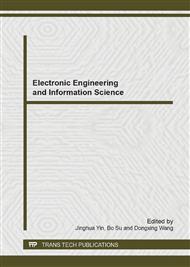p.262
p.267
p.275
p.279
p.287
p.295
p.299
p.304
p.310
An Improved Voice Activation Detection Method Based on Energy Acceleration Parameters and Support Vector Machine
Abstract:
Voice activation detection is a very important part in speech related domain. The classic voice activation detection normally depends on feature parameters in time or frequency domain, or parameters from statistical model. An improved voice activation detection method based on energy acceleration parameters and support vector machine is proposed in this paper. The energy acceleration parameters are the voice activation detection parameters in ETSI Advanced front-end feature extraction algorithm. The training period of support vector machine is based on energy acceleration parameters and manually appended class labels of each frame. In the detection period, the detection result is derived from energy acceleration parameters and Lagrange parameters calculated from training period. The experimental result shows that the false alarm rate of proposed method is greatly decreased. It has been observed that the voice activation detection proposed is better than the voice activation detection in ETSI Advanced front-end feature extraction algorithm.
Info:
Periodical:
Pages:
287-291
Citation:
Online since:
July 2014
Authors:
Price:
Сopyright:
© 2014 Trans Tech Publications Ltd. All Rights Reserved
Share:
Citation:


